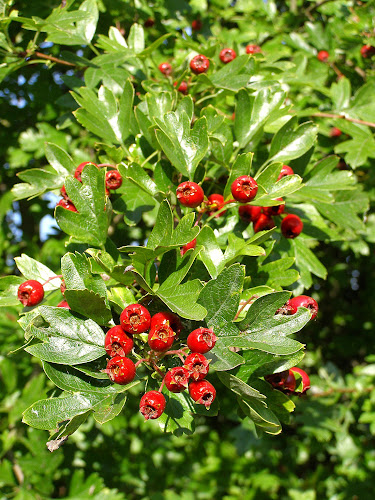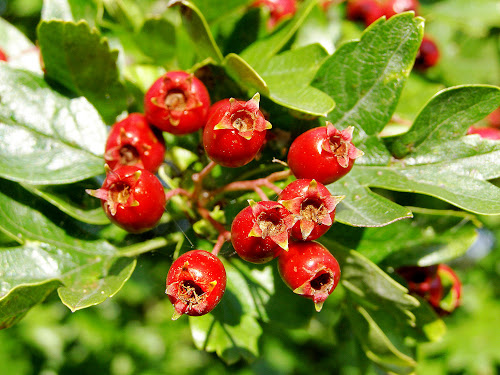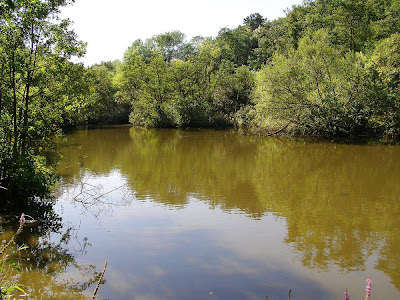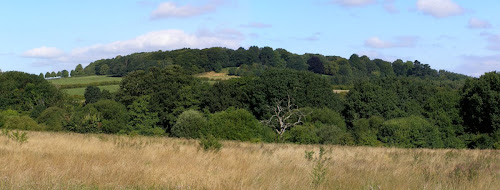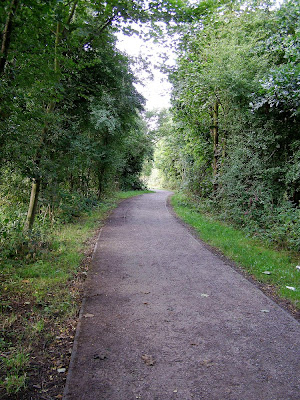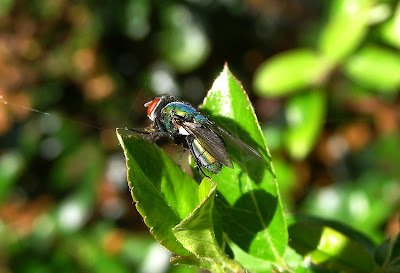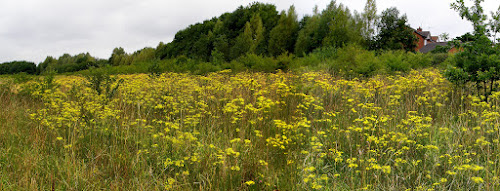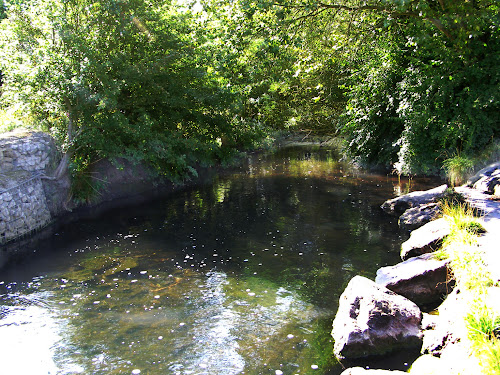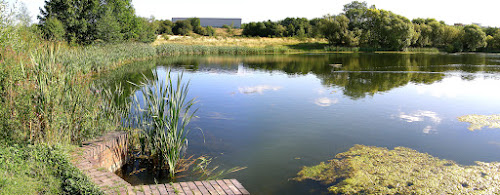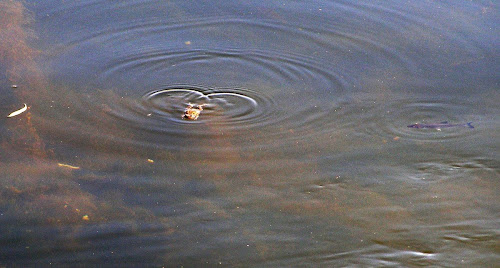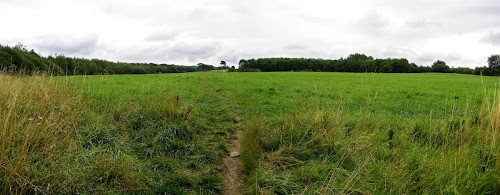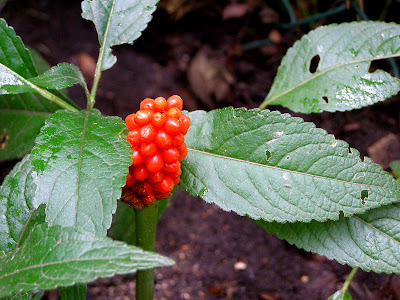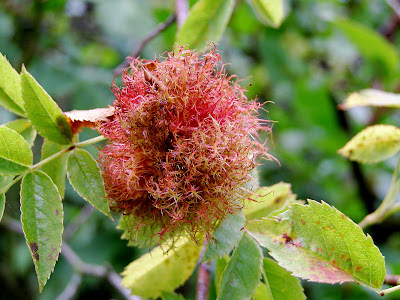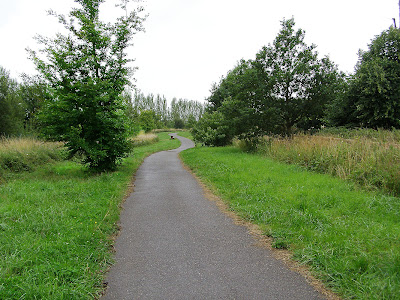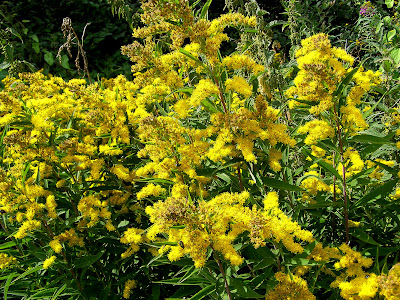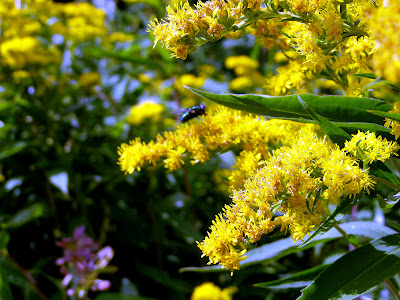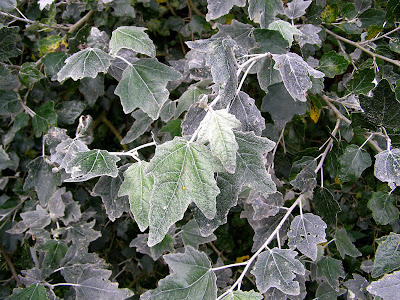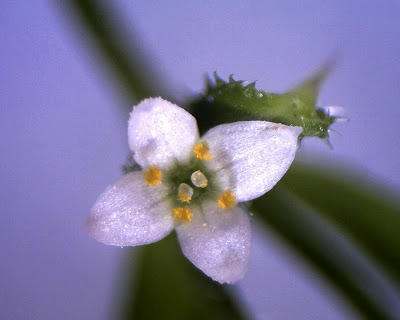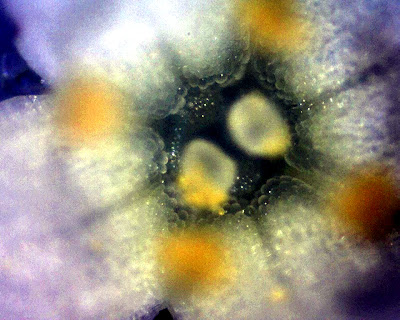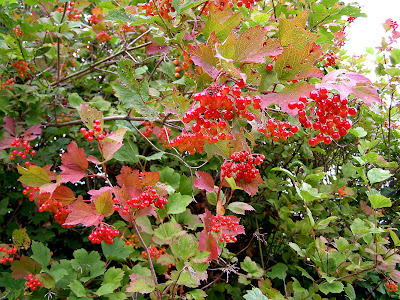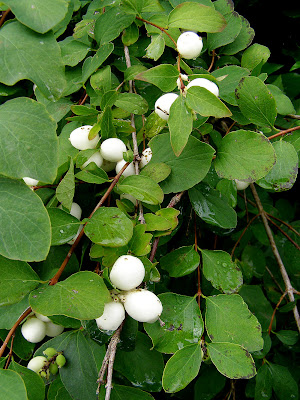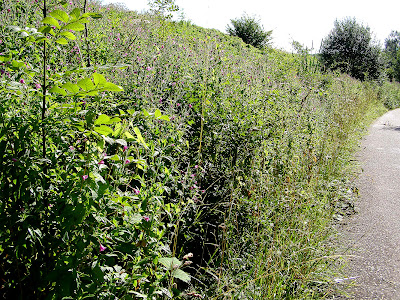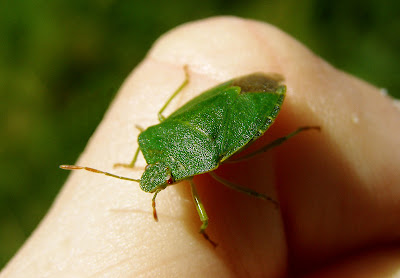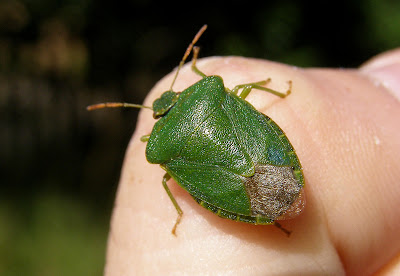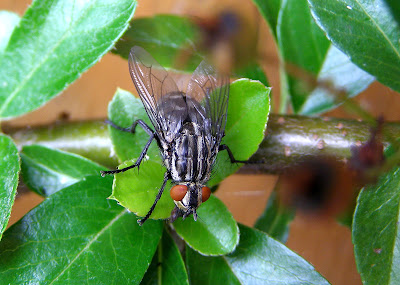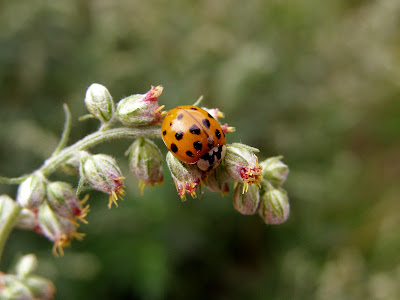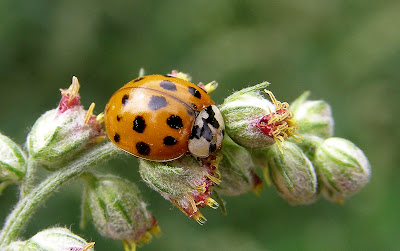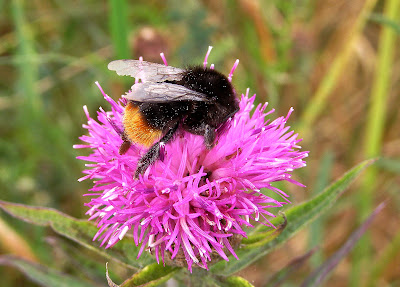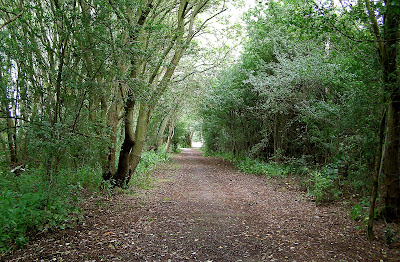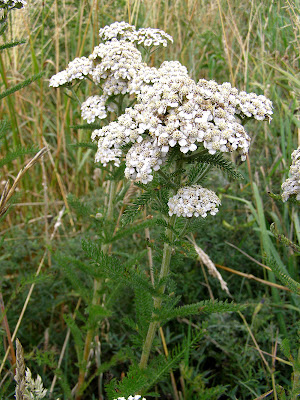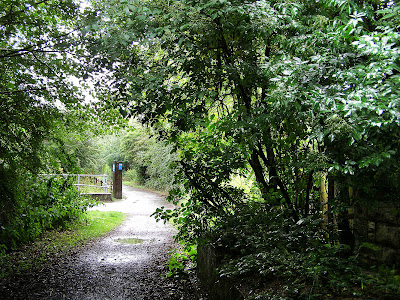A shorter walk this morning. Down to the Manor Floods, up through the golf course and into town. I went to the library while Malcolm did a little shopping, then it was a stroll back home past Victoria Park. The sun was shining beautifully, although the air was cool. Last night was the coldest yet this Autumn, with the temperature as low as 5.7C in our garden.
The hedgerows are showing more and more signs of drawing to a fruitful conclusion. Hawthorn is particularly resplendent with their bright red berries shining amongst the dark green leaves.
The fruit, or 'Haw' is not actually a berry at all. It is known as a 'Pome'. The best known examples of a Pome, are probably the Apple and Pear.
These Haws show the remnants of the five Sepals, which once surrounded the petals of the flower and are remarkably colourful in the morning sunshine.
Welcome to my blog. Don't expect anything too high-tech or flashy, this is simply a 'diary' to share some of my photos, thoughts and observations - with a particular bias towards the natural world and the countryside around my home.
Tuesday 31 August 2010
Monday 30 August 2010
Mapperley
What a pleasure it was this morning, to be able to get out and about again after the bad weather and yesterday's trip to King's Lynn, to return my mother home.
The sky was blue and the sun shone, but the breeze was still rather strong and was doing it's best to rip the leaves (and a few twigs) from the trees.
Here is our route this morning...
Mapperley Reservoir is rather lacking in water, something of a surprise after all the rain we've had recently. There are a number of very large Carp in the lake, which stir up a lot of mud from the bottom when searching for food. This makes the water very cloudy at times and often obscures the fish altogether.
There were a couple of Common Terns nesting on a man-made island in the reservoir earlier in the year, but they now seem to have left on their long migration journey (probably to South Africa). In their place were a pair of Black-headed Gulls, squabbling over the possession of a floating log.
Turning away from the reservoir and heading for home, the views across the surrounding farmland are quite good. Especially the view over the thistle-strewn meadows, towards Shipley Hill...
A closer view of the hill is always a pleasure... Lets hope the weather holds up for a while longer so we can get out and about a bit more.
The sky was blue and the sun shone, but the breeze was still rather strong and was doing it's best to rip the leaves (and a few twigs) from the trees.
Here is our route this morning...
Mapperley Reservoir is rather lacking in water, something of a surprise after all the rain we've had recently. There are a number of very large Carp in the lake, which stir up a lot of mud from the bottom when searching for food. This makes the water very cloudy at times and often obscures the fish altogether.
There were a couple of Common Terns nesting on a man-made island in the reservoir earlier in the year, but they now seem to have left on their long migration journey (probably to South Africa). In their place were a pair of Black-headed Gulls, squabbling over the possession of a floating log.
Turning away from the reservoir and heading for home, the views across the surrounding farmland are quite good. Especially the view over the thistle-strewn meadows, towards Shipley Hill...
A closer view of the hill is always a pleasure... Lets hope the weather holds up for a while longer so we can get out and about a bit more.
Saturday 28 August 2010
Looking Back
It is quite clear that Summer is coming to a close and Autumn is fast approaching. This morning, as we walked around Shipley Park, the first signs of Autumn were all around. Leaves are starting to turn golden and even starting to drop in some places, which seems a little premature. The shrubs and trees are full of ripening berries and some Autumnal fungi are beginning to push up through the grasses.
With all that in mind, I thought it would be nice to look back a few months to some of the bright, colourful scenes from around these parts when Spring was in full bloom and Summer was something to look forward to, rather than something to look back on and wonder where it went. So, here's a short video/slideshow of some of my pictures, taken at the time.
With all that in mind, I thought it would be nice to look back a few months to some of the bright, colourful scenes from around these parts when Spring was in full bloom and Summer was something to look forward to, rather than something to look back on and wonder where it went. So, here's a short video/slideshow of some of my pictures, taken at the time.
Friday 27 August 2010
Links
Two different 'links' this morning as Malcolm and I were glad to get out and about again after yesterday's enforced 'at home'. Having been to Tesco, we decided to take a short walk along Manner's Link, a local footpath which follows the old route of the railway lines - passenger and mineral.
The tall mast sticking up behind the trees in this picture, belongs to Ilkeston Police Station, built on the site of the Ilkeston North Railway Station.
Following the path towards what is now the Pewit Golf Course (the second of today's links), we passed through the trees which now line the way and hide the view of some new housing on the left.
Leaving the trees behind, the view opens out to take in the open aspect of Shipley Park, in the direction of Mapperley Village.
From there, the path skirts around Pewit Golf Course before emerging near the Manner's Flood and the ponds of Straw's Bridge. The golf course looks green and pleasant, but for wildlife, the neatly clipped grass is about as much use as a municipal car-park.
The tall mast sticking up behind the trees in this picture, belongs to Ilkeston Police Station, built on the site of the Ilkeston North Railway Station.
Following the path towards what is now the Pewit Golf Course (the second of today's links), we passed through the trees which now line the way and hide the view of some new housing on the left.
Leaving the trees behind, the view opens out to take in the open aspect of Shipley Park, in the direction of Mapperley Village.
From there, the path skirts around Pewit Golf Course before emerging near the Manner's Flood and the ponds of Straw's Bridge. The golf course looks green and pleasant, but for wildlife, the neatly clipped grass is about as much use as a municipal car-park.
Thursday 26 August 2010
Grounded
Yesterday, the BBC weather forecast said it would be bright, but cloudy today. So, of course, we woke this morning to high winds and rain. Honestly, how can the Met' Office get it so wrong, so often? They have some of the most powerful and sophisticated computer systems in the world, they have information flooding in from observation points all over the planet and yet, somehow, we would still be better off with a pine cone and a piece of seaweed dangling outside the window!
Never mind, maybe it will dry up later and we will be able to get out..... Let's hope!
Never mind, maybe it will dry up later and we will be able to get out..... Let's hope!
Wednesday 25 August 2010
Fly with me!
The Pyracantha in our garden is playing host to a plethora of flies and various creeping-crawling things. Among the more common are the Greenbottles (Lucilia caesar). The maggots of these little flies are especially keen on dead flesh and are used in the medical profession for cleaning-up wounds by eating the decaying flesh, while leaving the living flesh well alone.
Our Lavender plant is also being well used at the moment, by a few different types of Bee. There are Carder Bees, White-tailed Bumblebees, occasional Honey Bees and this little chap, a Buff-tailed Bumblebee (Bombus terrestris). Almost identical to it's White-tailed cousin, they are not easy to separate. I have spoken a lot about the various 'invasive species' which can cause such problems in this country, but the Buff-tailed Bumblebee is considered an invasive species in Japan and it has been the subject of legislation in Australia, to ban it's live import as it poses a threat to Australia's native bees. Still, nice in the right place - on our lavender plant!
Our Lavender plant is also being well used at the moment, by a few different types of Bee. There are Carder Bees, White-tailed Bumblebees, occasional Honey Bees and this little chap, a Buff-tailed Bumblebee (Bombus terrestris). Almost identical to it's White-tailed cousin, they are not easy to separate. I have spoken a lot about the various 'invasive species' which can cause such problems in this country, but the Buff-tailed Bumblebee is considered an invasive species in Japan and it has been the subject of legislation in Australia, to ban it's live import as it poses a threat to Australia's native bees. Still, nice in the right place - on our lavender plant!
Tuesday 24 August 2010
Ragwort
There is a particularly common plant in Britain which, although beautiful to look at, is in fact, a poisonous, nasty piece of work. That plant is called Common Ragwort (Jacobaea vulgaris or Senecio jacobaea). Everyone knows Ragwort. It's bright-yellow flowers are a constant part of the British countryside during the Summer and is a favourite food plant for the caterpillar of the Cinnabar Moth (Tyria jacobaeae). It does however, contain several different poisonous alkaloids, enough to warrant a whole report by the World Health Organisation. Farm animals are usually not affected by Ragwort as they seem to know it and avoid it while it is growing in the fields. The problem comes when it is cut and dried and forms part of the hay, fed to cattle and horses. It can then start to attack the livers of the unfortunate animal, causing cirrhosis. But, what a beautiful plant it is, despite this 'dark side'.
Another quick picture from a few days ago, this time taken looking along the old Nutbrook Canal (or what's left of it). The sun filtering through the trees and illuminating the fast-flowing waters, was delightful. Just right to stand and take it all in, quietly for a few moments.
Another quick picture from a few days ago, this time taken looking along the old Nutbrook Canal (or what's left of it). The sun filtering through the trees and illuminating the fast-flowing waters, was delightful. Just right to stand and take it all in, quietly for a few moments.
Monday 23 August 2010
Bogwash
Malcolm and I had a short walk around the Straw's Bridge ponds this morning. We were not hopeful of getting a walk at all having seen the weather forecast, but it turned out to be rather pleasant. It was, however, rather 'boggy' under foot. The largest of the ponds is known as the Manor Floods. This, like many other parts around here, was once a scene of industrial and mining chaos with railway lines and an old mine shaft belonging to the long-defunct Rutland Colliery. The large building in the background, which is now part of the Manners Industrial estate, occupies the position of an old electric power station. By far the hardest work on this site these days, seems to be that of the Coots, still feeding young and constantly squabbling amongst themselves.
While we were here yesterday, we were enchanted by the sight of a small frog swimming for all he was worth against the 'tide' of water flowing into the lake from an overflow pipe...Bless him, he was even being watched by a small fish!
I have just uploaded a short slide show of some of my photos, taken around the area, set to the beautiful piece of music, 'Greenwaves' by Secret Garden. Hope you like it...
While we were here yesterday, we were enchanted by the sight of a small frog swimming for all he was worth against the 'tide' of water flowing into the lake from an overflow pipe...Bless him, he was even being watched by a small fish!
I have just uploaded a short slide show of some of my photos, taken around the area, set to the beautiful piece of music, 'Greenwaves' by Secret Garden. Hope you like it...
Sunday 22 August 2010
43
Well, another year has sprinted past at lightning speed and today, I've reached the dizzying heights of 43 years old. What happened to 42? Last thing I remember I was about 25!
Having made it a theme to post old photos of other family members on their birthdays, I suppose I have to do the same to myself in the interests of fairness. So, here goes, brace yourself and all say aarrhh!!
I think I was 4 or 5 when this was taken - I haven't changed a bit!! If you believe that, you can knit fog. Where's the Gin?
Having made it a theme to post old photos of other family members on their birthdays, I suppose I have to do the same to myself in the interests of fairness. So, here goes, brace yourself and all say aarrhh!!
I think I was 4 or 5 when this was taken - I haven't changed a bit!! If you believe that, you can knit fog. Where's the Gin?
Saturday 21 August 2010
Hawker
After a couple of days without a good walk (although we did have a short stroll around the top of Shipley Hill yesterday), it was good to get out again today for a longer walk around the old theme-park site. We were looking for Blackberries again - and we managed to pick a good number - but by far the best thing we saw this morning was a Brown Hawker (Aeshna grandis).
The Brown Hawker is one of our largest Dragonfly species and is fairly common. Like small helicopters, they fly past you, making quite a loud noise from it's beating wings. This individual was a male as can be discerned from it's 'waist', just below the two blueish spots on the abdomen. Females lack this 'waist' and the two blue spots.
The bronze colour of the wings and body of this species, make it fairly easy to identify on the wing as it flits past, usually at high speed.
The Brown Hawker is one of our largest Dragonfly species and is fairly common. Like small helicopters, they fly past you, making quite a loud noise from it's beating wings. This individual was a male as can be discerned from it's 'waist', just below the two blueish spots on the abdomen. Females lack this 'waist' and the two blue spots.
The bronze colour of the wings and body of this species, make it fairly easy to identify on the wing as it flits past, usually at high speed.
Wednesday 18 August 2010
New track
Yesterday, Malcolm and I had a shorter walk through Shipley Park, and decided to take a walk across some previously, unexplored fields nearby.
The area, is bounded on one side by the Northern extent of our housing estate, by the Hospital grounds and the woodland which bounds the old entrance-drive to Shipley Hall. Those woods are to be seen on the left in this picture, while the track of our walk can be seen crossing the field, in the middle.
As I have mentioned before, the area was very different in times gone by. Here, in the late 19th century, there was to be found a Brick-works, connected to the Woodside Colliery. The view in the following picture, (taken, looking in the opposite direction to the last picture) of Shipley Hill in the distance, beyond the fields and trees, would once have looked across railway tracks and canal wharfs, docks and locks.
The view today is far more picturesque, I'm sure you will agree.
The area, is bounded on one side by the Northern extent of our housing estate, by the Hospital grounds and the woodland which bounds the old entrance-drive to Shipley Hall. Those woods are to be seen on the left in this picture, while the track of our walk can be seen crossing the field, in the middle.
As I have mentioned before, the area was very different in times gone by. Here, in the late 19th century, there was to be found a Brick-works, connected to the Woodside Colliery. The view in the following picture, (taken, looking in the opposite direction to the last picture) of Shipley Hill in the distance, beyond the fields and trees, would once have looked across railway tracks and canal wharfs, docks and locks.
The view today is far more picturesque, I'm sure you will agree.
Monday 16 August 2010
72
Once again, today sees my mum's birthday. 72 today!
On this day, 51 years ago, mum posed beside her collection of 21st birthday gifts arranged on her parents' sideboard. Strange what you remember, but I can still recall as a child, seeing the table lamp in the shape of a yacht and I think mum still has the cruet set in the form of a ship and the oriental style jewelery box. I think the cake has gone by now though!
Happy birthday mum....
On this day, 51 years ago, mum posed beside her collection of 21st birthday gifts arranged on her parents' sideboard. Strange what you remember, but I can still recall as a child, seeing the table lamp in the shape of a yacht and I think mum still has the cruet set in the form of a ship and the oriental style jewelery box. I think the cake has gone by now though!
Happy birthday mum....
Sunday 15 August 2010
Mapperley
Just one picture for today, but a big one! This is a view, taken from our walk this morning, which took us along the old railway lines from the long-defunct mine workings of West Hallam and Mapperley, to Slack Road, turning towards the village of Mapperley before heading home again.
The picture is a composite of four, stitched together to make one long panorama, looking towards Mapperley, from Slack Road, close to Head House Farm. From here, you can just see the rooftops of Mapperley Village in the centre of the picture as well as Shipley Hill and Slack Road, on the far right.
The village of Mapperley has changed a lot over the years. Essentially a farming community, it was once a hive of industrial activity. Coal and ironstone were mined here in the 18th and 19th centuries, but more shallow coal mines had been on the site for at least two hundred years before then. Output was always hampered by the ever-present problem of poor drainage and communications. The advent of roads, tram-ways and eventually the Nutbrook Canal system, helped matters, as did the later arrival of the Railways which had a branch line built directly to the colliery at Mapperley. Now, with the mines all gone, the landscape has once again returned to a more rural idyll and the smell of hundreds of dairy cattle has replaced the stench of industry!
Saturday 14 August 2010
Fruit
After the dreadful weather yesterday which prevented us from taking our usual walk around the parkland and forced us, instead to take an afternoon walk into town (not a pleasant experience), it was nice to get out again this morning, despite the threatening clouds. We did manage to get a walk around the old Theme Park site, gathering more Blackberries on the way. And quite a 'haul' of blackberries there were too! It seems the rain of the last few days has really swollen the fruits and the warmth has ripened them nicely.
The Blackberries were not the only plants to be in fruit. Amongst the undergrowth of the trees around the area, are a number of Lords and Ladies (Arum maculatum), ripening into bright red, beacons in the darkness under the trees.
You may remember I mentioned these plants earlier in the year when they were starting to open their flowers (HERE). Well, the fruits of their labours are now clear to see. The berries are very poisonous, although they are so unpleasant to taste, that it is very rare for anyone to eat enough of them to do much harm. They contain sharp, needle-shaped chrystals of 'saponins', which irritate the skin of the mouth, tongue and throat, causing swelling and resultant difficulty in breathing, pain and stomach upset. All that, from such a beautiful plant..
Growing on some of the wild roses which line the paths of Shipley Park, are a few strange-looking, 'fluffy' structures. Known as Robin's Pincushions', they are a gall formed by a tiny gall-wasp called Diplolepis rosae.
The insect lays up to 60 eggs in an unopened leaf bud and this leads to a chemical irritation within the shrub. as a result, the rose starts to grow in a deformed manner, making these attractive, red-tinged balls of feathery material instead of the leaf it should have become. The growth serves to protect the larvae, growing within, which, by late October have stopped growing and prepares to overwinter. In the middle of the winter, the larvae pupates within the 'pincushion' and starts to emerge as adult 'wasps' from May onwards.
Returning home with a bag full of Blackberries, we started to climb the path back around Shipley Hill. Difficult to imagine that this area was like a scene from hell only about 60 years ago, when it was the site of extensive, open-cast mining works. It looks a lot better now, even in the dull weather.
Now.....
...and then...
The Blackberries were not the only plants to be in fruit. Amongst the undergrowth of the trees around the area, are a number of Lords and Ladies (Arum maculatum), ripening into bright red, beacons in the darkness under the trees.
You may remember I mentioned these plants earlier in the year when they were starting to open their flowers (HERE). Well, the fruits of their labours are now clear to see. The berries are very poisonous, although they are so unpleasant to taste, that it is very rare for anyone to eat enough of them to do much harm. They contain sharp, needle-shaped chrystals of 'saponins', which irritate the skin of the mouth, tongue and throat, causing swelling and resultant difficulty in breathing, pain and stomach upset. All that, from such a beautiful plant..
Growing on some of the wild roses which line the paths of Shipley Park, are a few strange-looking, 'fluffy' structures. Known as Robin's Pincushions', they are a gall formed by a tiny gall-wasp called Diplolepis rosae.
The insect lays up to 60 eggs in an unopened leaf bud and this leads to a chemical irritation within the shrub. as a result, the rose starts to grow in a deformed manner, making these attractive, red-tinged balls of feathery material instead of the leaf it should have become. The growth serves to protect the larvae, growing within, which, by late October have stopped growing and prepares to overwinter. In the middle of the winter, the larvae pupates within the 'pincushion' and starts to emerge as adult 'wasps' from May onwards.
Returning home with a bag full of Blackberries, we started to climb the path back around Shipley Hill. Difficult to imagine that this area was like a scene from hell only about 60 years ago, when it was the site of extensive, open-cast mining works. It looks a lot better now, even in the dull weather.
Now.....
...and then...
Thursday 12 August 2010
Gold, Green and White
Three colours were prominent this morning as Malcolm and I walked around the Straw's Bridge lakes. Firstly the Gold of the Canadian Goldenrod (Solidago canadensis).
This plant, as the name implies is not a native to the British Isles, but has, like many other invasive plants, become very common across the whole of Europe. Like the Rosebay Willowherb, it is often among the first species of plant to colonise an area which has been disturbed by fire. It has also been a favourite garden flower for many years, indeed, we had a patch of it in our front garden when I was a small boy. It is from these gardens, that the plant has spread throughout the land. It is a very popular plant with a whole host of insects and this stand of Goldenrod was certainly living up to this reputation. The flowers were covered with Greenbottles, Bluebottles, Hoverflies, Bees and Beetles.
Here, a Greenbottle (Phaenicia sericata) is to be seen feeding on the nectar.
In the hedges along the Nutbrook Canal, there are several White Poplar trees (Populus alba). This medium-sized tree is a member of the Aspen family 'salicaceae'. This family includes the willows, another common tree in the hedgerows. The White Poplar gets its name from the white covering of small hairs on the leaf surface which gives the tree an all-over white colour.
This plant, as the name implies is not a native to the British Isles, but has, like many other invasive plants, become very common across the whole of Europe. Like the Rosebay Willowherb, it is often among the first species of plant to colonise an area which has been disturbed by fire. It has also been a favourite garden flower for many years, indeed, we had a patch of it in our front garden when I was a small boy. It is from these gardens, that the plant has spread throughout the land. It is a very popular plant with a whole host of insects and this stand of Goldenrod was certainly living up to this reputation. The flowers were covered with Greenbottles, Bluebottles, Hoverflies, Bees and Beetles.
Here, a Greenbottle (Phaenicia sericata) is to be seen feeding on the nectar.
In the hedges along the Nutbrook Canal, there are several White Poplar trees (Populus alba). This medium-sized tree is a member of the Aspen family 'salicaceae'. This family includes the willows, another common tree in the hedgerows. The White Poplar gets its name from the white covering of small hairs on the leaf surface which gives the tree an all-over white colour.
Wednesday 11 August 2010
Nectar, Close-up
A couple more pictures from my 'new toy', the USB microscope. This time of a familiar flower. The plant called Cleavers (Galium aparine) is well known to us all, but often under many different names. As children, we knew it as 'Sticky Willy' but it is also known as Goosegrass, Stickyweed, Stickyleaf, Catchweed, Robin-run-the-hedge and many more. Who hasn't picked a piece of it and thrown it at someone and seen it 'stick' to their clothing as it's thousands of minute hooks snagged into the fibres?
The flowers of this plant are very small, white and probably not usually seen, but they are nevertheless rather lovely when seen at 60 times magnification.
Looking closer and you can see why small insects like this flower so much. Located at the base of the petals, right inside the flower (an area known as the perianth), are the necatries. These are the 'glands' which produce the sugary nectar which many insects crave and which offers them a reward for their pollination of the flower. Seen here at 200 times magnification, the tiny beads of nectar are clearly visible. The whole of the inside seems to be wet with nectar, a welcome meal for any insect small enough to get at it.
Nectar is a complex compound of chemicals. As well as the sugars which make it so palatable to pollinating insects (as well as birds, bats and other animals, depending on the flower), there may be many other chemicals too, such as various aromas to attract the animal. Some plants, actually produce a foul-tasting substance in the nectar, counter-productive you might think, but it is thought that this discourages an animal from taking too much nectar at one time and persuades it to visit other flowers, so increasing the chances of pollination. Clever eh?
The flowers of this plant are very small, white and probably not usually seen, but they are nevertheless rather lovely when seen at 60 times magnification.
Looking closer and you can see why small insects like this flower so much. Located at the base of the petals, right inside the flower (an area known as the perianth), are the necatries. These are the 'glands' which produce the sugary nectar which many insects crave and which offers them a reward for their pollination of the flower. Seen here at 200 times magnification, the tiny beads of nectar are clearly visible. The whole of the inside seems to be wet with nectar, a welcome meal for any insect small enough to get at it.
Nectar is a complex compound of chemicals. As well as the sugars which make it so palatable to pollinating insects (as well as birds, bats and other animals, depending on the flower), there may be many other chemicals too, such as various aromas to attract the animal. Some plants, actually produce a foul-tasting substance in the nectar, counter-productive you might think, but it is thought that this discourages an animal from taking too much nectar at one time and persuades it to visit other flowers, so increasing the chances of pollination. Clever eh?
Tuesday 10 August 2010
Berry
You can be assured that Autumn is on it's way when the hedgerow starts to be filled with the fruits of it's Summer labours. This morning, Malcolm and I had a walk around the old lake which once formed part of the Shipley Hall estate and later formed the central lake of the American Adventure Theme Park. The walk itself is always pleasant, but at this time of the year, there is the added benefit of the Blackberries to be picked. Although, this year the fruits are rather small and shrivelled, following the very dry conditions during the early summer. Harking back to our 'hunter-gatherer' origins, we did manage to collect a small bag full and will enjoy them later! There are also many other berries filling the hedgerows right now. Among the most colourful are those belonging to the Guelder Rose (Viburnum opulus).
The berries are edible, but only in small quantities. They are very bitter to taste and in larger quantity, they may cause vomiting and diarrhoea. They are best eaten (if at all) in the form of a jam. The bark of this shrub is useful when dried and made into a tincture, for alleviating menstrual pain. For that reason, it has been known historically as 'Cramp Bark'.
alongside these bright, red berries, there are a number of Snowberry Bushes (Symphoricarpos albus). These berries are poisonous to humans producing symptoms similar to those mentioned above, but also dizziness and mild sedation.
The footpaths are all rather full at this time of year, with the Great Willowherb, Brambles, Ash trees, Alders, Angelica, Nettles and Hogweed all competing to be the tallest thing in the shrubbery.
The berries are edible, but only in small quantities. They are very bitter to taste and in larger quantity, they may cause vomiting and diarrhoea. They are best eaten (if at all) in the form of a jam. The bark of this shrub is useful when dried and made into a tincture, for alleviating menstrual pain. For that reason, it has been known historically as 'Cramp Bark'.
alongside these bright, red berries, there are a number of Snowberry Bushes (Symphoricarpos albus). These berries are poisonous to humans producing symptoms similar to those mentioned above, but also dizziness and mild sedation.
The footpaths are all rather full at this time of year, with the Great Willowherb, Brambles, Ash trees, Alders, Angelica, Nettles and Hogweed all competing to be the tallest thing in the shrubbery.
Monday 9 August 2010
Bug
This morning's short walk into town (to return my library book), took us, as usual, along the footpath around the industrial estate, then up, past Victoria Park. Coming back home, I spotted this little insect crawling along the footpath. A Common Green Shield Bug (Palomena prasina). Here, sitting on my thumb.
The adult bug lays it's eggs on the underside of leaves, followed by the larvae which feed on the sap of the leaves. Later in the year, the larvae change into adults which also feed on sap. Before hibernation, in the Autumn, the adults begin to turn a darker colour, from the bright green of Summer, to brown.
A charming little insect, I think you'll agree..
The adult bug lays it's eggs on the underside of leaves, followed by the larvae which feed on the sap of the leaves. Later in the year, the larvae change into adults which also feed on sap. Before hibernation, in the Autumn, the adults begin to turn a darker colour, from the bright green of Summer, to brown.
A charming little insect, I think you'll agree..
Sunday 8 August 2010
Fly
Say "yuk" if you like, but the topic for today is this 'charming' little creature, the Flesh Fly (Sarcophaga carnaria). This one was scurrying around our garden this morning.
These are familiar members of the order Diptera (true flies) but are almost universally detested for their unpleasant habits. For a start, the name Sarcophaga means 'flesh-eating', a reference to the larval stage of the fly - the familiar maggot. Flies lay their eggs on a variety of things, particularly dead and decaying flesh, but also open wounds of living animals. The eggs hatch into maggots which feed on the host animal or carcass. They remain, growing, in that state for 5 - 10 days, before pupating underground. Emerging as the fully-formed adult fly, which lives a further 5 - 7 days.
Flesh Flies are also viviparous, meaning that they can give birth to fully formed, young flies too. This they do most often on a decaying corpse.
The Flesh Fly's association with disease is well documented and is a known carrier of Leprosy as well as intestinal 'worms' from the maggots. But they can also be very useful. The Forensic scientist will look at the development of Flesh Fly maggots on a corpse along with temperature and position, to establish the time of death. The maggots are also useful at controlling other insect larvae, beetles, caterpillars, snails, etc. So, you see, it's not all bad!
These are familiar members of the order Diptera (true flies) but are almost universally detested for their unpleasant habits. For a start, the name Sarcophaga means 'flesh-eating', a reference to the larval stage of the fly - the familiar maggot. Flies lay their eggs on a variety of things, particularly dead and decaying flesh, but also open wounds of living animals. The eggs hatch into maggots which feed on the host animal or carcass. They remain, growing, in that state for 5 - 10 days, before pupating underground. Emerging as the fully-formed adult fly, which lives a further 5 - 7 days.
Flesh Flies are also viviparous, meaning that they can give birth to fully formed, young flies too. This they do most often on a decaying corpse.
The Flesh Fly's association with disease is well documented and is a known carrier of Leprosy as well as intestinal 'worms' from the maggots. But they can also be very useful. The Forensic scientist will look at the development of Flesh Fly maggots on a corpse along with temperature and position, to establish the time of death. The maggots are also useful at controlling other insect larvae, beetles, caterpillars, snails, etc. So, you see, it's not all bad!
Saturday 7 August 2010
Insect
No blog entry yesterday, as Malcolm and I had the sad occasion of the funeral of our friend Moira to attend. But today, we set out around Shipley Park for a stroll along Slack Lane and through the farmyard of Head House Farm and the collection of old farm buildings associated with the area - now known as 'The Brook'. From there, it was under the old Mapperley Branch Line of the mineral railways which I have mentioned before, then turning back along more old rail tracks and spoil from West Hallam Colliery and home again.
On one of the many, large Mugwort plants, which grow along these paths, I spotted (no pun intended) this spotty little creature. A Harlequin Ladybird (Harmonia axyridis succinea).
The Harlequin Ladybirds are very variable in colour and the pattern of spots on their wing cases (elytra). This can make it difficult to distinguish a true Harlequin from the many different species of native Ladybird. Help can be had from this website
Harlequins (or Multicoloured Asian Ladybirds), have staged a remarkable invasion of Britain and almost everywhere else in the world over the last few years and started to cause problems to our native species because they prey upon their eggs and larvae.
The spread of these little invaders can be seen from the maps on this page.
Another insect species seen this morning, this time on the many Knapweed flowers which adorn the parkland right now, was this Red-tailed Bumblebee. (Bombus lapidarius).
This individual was showing some wear and tear on the edges of its wings, but didn't seem too worried by that as it buried its head into the nectar-rich flowers. Like all bees in Britain, it is under threat and its numbers have fallen considerably over recent times. The exact causes for this are still a matter for debate. But for now, its nice to see them busy in the meadows around Shipley Park.
On one of the many, large Mugwort plants, which grow along these paths, I spotted (no pun intended) this spotty little creature. A Harlequin Ladybird (Harmonia axyridis succinea).
The Harlequin Ladybirds are very variable in colour and the pattern of spots on their wing cases (elytra). This can make it difficult to distinguish a true Harlequin from the many different species of native Ladybird. Help can be had from this website
Harlequins (or Multicoloured Asian Ladybirds), have staged a remarkable invasion of Britain and almost everywhere else in the world over the last few years and started to cause problems to our native species because they prey upon their eggs and larvae.
The spread of these little invaders can be seen from the maps on this page.
Another insect species seen this morning, this time on the many Knapweed flowers which adorn the parkland right now, was this Red-tailed Bumblebee. (Bombus lapidarius).
This individual was showing some wear and tear on the edges of its wings, but didn't seem too worried by that as it buried its head into the nectar-rich flowers. Like all bees in Britain, it is under threat and its numbers have fallen considerably over recent times. The exact causes for this are still a matter for debate. But for now, its nice to see them busy in the meadows around Shipley Park.
Thursday 5 August 2010
Carr
The word Carr probably comes from an old Norse word meaning 'underbrush' and has been used in it's English form as meaning a wet woodland, for centuries. The local nature reserve in these parts, called Pewit Carr, certainly lives up to that definition. The area is packed with typical, wetland trees and flowers including Willows, Alders, Ash and Hazel. I mentioned in yesterday's blog entry, the old railway lines, bridges and general residue from the area's industrial and mining past. Well, today we re-traced our steps and had a more leisurely stroll around the area. The footpaths follow the old tracks of the railway lines and you can even see the remains of some of these rails, still sticking out of the undergrowth in some places. Here, the path of the old mineral railway is clearly visible as it runs around the back of houses in West Hallam and the playing fields.
among the flowers to be found along the footpaths around here, is a useful little plant called Yarrow (Achillea millefolium).
The name 'millefolium' means 'thousand leaves' and refers to the much-divided leaves which give the plant the look of having 'thousands' of little leaves.
The flowers are held in dense clusters, called corymbs, atop the stems. The flowers can indicate the nature of the soil on which the plant is growing, for instance, if the flowers are all white (as in this case), then the soil it is growing in is almost certainly calcium rich and therefore alkaline. If the flowers are in part (or wholly) pinkish in colour, then the soil must be acidic.
The plant has been used in medicine for many centuries and has a number of uses. These include use as a diaphoretic (to make the patient sweat), antipyretic (reduces fever), diuretic, urinary antiseptic, anti-inflammatory, digestive stimulant and menstrual stimulant, to name but a few!
among the flowers to be found along the footpaths around here, is a useful little plant called Yarrow (Achillea millefolium).
The name 'millefolium' means 'thousand leaves' and refers to the much-divided leaves which give the plant the look of having 'thousands' of little leaves.
The flowers are held in dense clusters, called corymbs, atop the stems. The flowers can indicate the nature of the soil on which the plant is growing, for instance, if the flowers are all white (as in this case), then the soil it is growing in is almost certainly calcium rich and therefore alkaline. If the flowers are in part (or wholly) pinkish in colour, then the soil must be acidic.
The plant has been used in medicine for many centuries and has a number of uses. These include use as a diaphoretic (to make the patient sweat), antipyretic (reduces fever), diuretic, urinary antiseptic, anti-inflammatory, digestive stimulant and menstrual stimulant, to name but a few!
Wednesday 4 August 2010
Swift and Wet
We had put our daily walk off until after lunch today because of the rain this morning. So, it was a quick dash around the Manners Floods, through Pewit Carr and back round Straw's Bridge, always with one eye on the looming clouds and one hand on the umbrella. What good thing we took the brolly. Half way round our walk and a few spots started to fall, followed by a few more, then more and soon it was pouring. Luckily, the Victorian engineers who built the old system of mineral railway lines around these parts, for the transportation of coal and ore, included a number of small bridges for us to shelter under! What foresight they had!
Just one photo today, of our path back home, taken from under one of those bridges as the rain fell.
Ten minutes later and we were on our way again and managed to get home in the dry once more, although the clouds are still threatening!
Just one photo today, of our path back home, taken from under one of those bridges as the rain fell.
Ten minutes later and we were on our way again and managed to get home in the dry once more, although the clouds are still threatening!
Subscribe to:
Posts (Atom)

